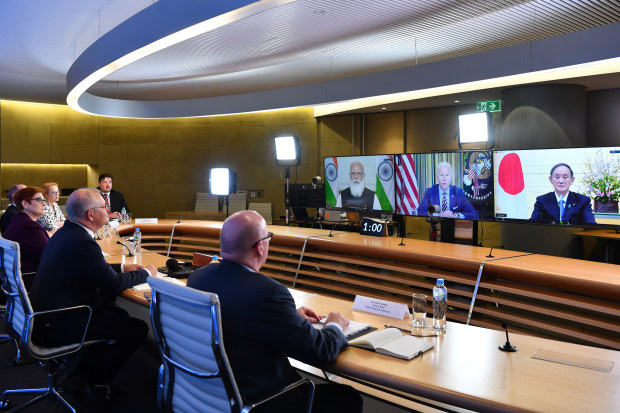China’s AUKUS wedge tactics won’t divide India from the Quad

Beijing’s slamming of the nuclear subs pact will not work. New Delhi will view the enhanced regional defence deterrence as complementary to the security dialogue and a boon to its interests.
As the aftershocks from last week’s trilateral defence pact between Australia, the United Kingdom and the United States (AUKUS) reverberate, the leaders of the Quad will conduct their first ever face-to-face meeting in Washington on Friday (September 24) only four years after the group’s re-emergence.
Beijing has begun a diplomatic offensive on two fronts. The Chinese foreign ministry has slammed the formation of AUKUS as having “undermined regional peace and stability” and “intensified the arms race”, while the state-owned Global Times has taken a different tack, casting it as a demonstration of Washington’s “special treatment” of Australia, elevating it above India and Japan, thereby dealing both a “psychological blow”.

The latter is an attempt to drive a wedge between Quad member nations and damage perceptions of AUKUS at the same time. That will not work on Japan, which has world-class diesel submarines and strong defence relationships with the US and Australia. The real Chinese objective of the divide-and-rule strategy is to cause India to decrease its support for the Quad.
In an immediate response, its foreign secretary, Harsh Shringla, declared AUKUS was “neither relevant to the Quad, nor will it have any impact on its functioning”. That is just a holding position, but Beijing shouldn’t hold its breath. It is likely India will increasingly view AUKUS as complementary of the Quad and its own strategic interests.
With India fielding one nuclear-powered submarine compared to China’s eight, Australia’s acquisition of eight nuclear-powered submarines will make a significant contribution to balancing against China’s growing maritime capabilities.
Any pact that enhances Australia’s standalone and collective capabilities to deter Chinese expansionism across the vast oceans of the Indo-Pacific is a boon to India. Of the Quad members, India was the most reticent to reconstitute the grouping in 2017 because of underlying doubts about Australia’s resolve to oppose Beijing due to our dependency on the Chinese market and the ability of our military to serve as a counter to China.
On Australian resolve, Indian doubts no longer exist, given Australia’s determination to remain firm in the face of sustained Chinese economic coercion. Indeed, it has become the model of a smaller nation standing up to China.
The AUKUS pact will similarly help reduce doubts about what Australia brings to the table when it comes to the military capability to credibly deter China. Nuclear submarines are highly coveted for their superior stealth, speed, range and endurance compared to conventionally powered fleets. With India fielding one nuclear-powered submarine compared to China’s eight, Australia’s acquisition of eight nuclear-powered submarines via AUKUS, albeit by 2040, will make a significant contribution to balancing against China’s growing maritime capabilities.
Meanwhile, Australia is likely to lease or buy existing submarines from the US and UK in the coming years. India, as the other Quad country geographically resident in the Indian Ocean, will welcome the additional deterrent and intelligence-collection capabilities Australia will bring to that maritime theatre.
Moreover, AUKUS goes beyond a submarine deterrent. It will activate Australia and the UK’s inclusion in the US National Technology Industrial Base and clear the way for deep military-industrial collaboration between the three countries on cyber capabilities, applied artificial intelligence, quantum technologies and undersea capabilities, including the integration of defence supply chains.
Further, the pact will enhance Australia’s long-range strike capability across all domains through the acquisition of Tomahawk cruise missiles, long-range anti-ship missiles, and collaboration with the US to develop hypersonic missiles, all designed to hold potential adversaries’ forces and infrastructure at risk from a greater distance.
AUKUS and the Quad serve different but complementary purposes that advance India’s own interests. AUKUS is a military-industrial alliance between three countries that have fought major wars together, are the most important members of the formidable Five Eyes intelligence grouping and have shared values and histories.
Whilst the Quad will allow the four members to use their military capabilities and geographic reach to deter Chinese expansionism, it seeks to do much more than that.
The Quad also aims to counter China’s determination to set regional discourse, promote its own authoritarian norms and values, dominate the technologies of the future and create a hierarchical economic order with the middle kingdom at the centre.
No comments:
Post a Comment